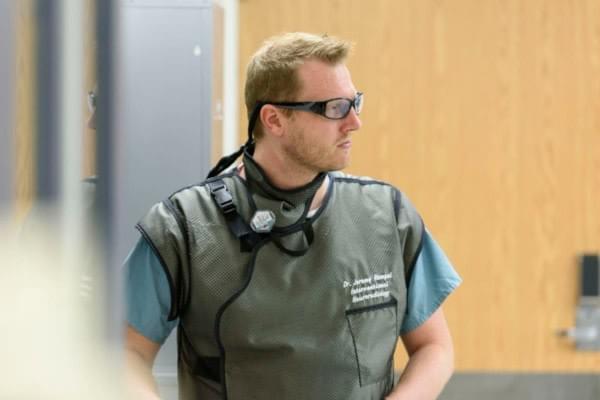- 1-833-448-3843 Make a call.
- info@givetouhf.ca Drop us an email.
- We are located in Edmonton, Alberta
Meet the Doc: Dr. Jeremy Rempel
 This month meet Dr. Jeremy Rempel, a stroke doctor at the University of Alberta Hospital
This month meet Dr. Jeremy Rempel, a stroke doctor at the University of Alberta Hospital
Dr. Jeremy Rempel knows what it means to save lives on a daily basis. And thanks to the University Hospital Foundation’s Brain Centre Campaign, Dr. Rempel and his team now have the capacity to save more lives than ever before.
1. Where are you from?
I grew up in southern Manitoba on a farm five miles from the town of Niverville – which is 30 kilometers south of Winnipeg. My parents still live in the house I grew up in.
2. When and how did you decide to become a doctor?
Actually, my wife Tara talked me into it. We went to high school together – and I was always interested in academics. I thought maybe Engineering was a possibility. One day she said to me, “You’d be a good doctor.” I did a little exploring, and the rest is history, I guess.
I got my Bachelor’s degree at the University of Winnipeg, then went to medical school at the University of Manitoba. From there I received my training in radiology from Memorial University in St. John’s, Newfoundland, which at the time was the smallest program like that in the country. There were only three residents total, which allowed for a lot more hands-on experience than I would have received anywhere else.
And then, I did a three-year Interventional and Diagnostic Neuroradiology fellowship at the University of Toronto. Ultimately, my family and I decided to come to Edmonton because it was the best balance of a great job with great people (the neurovascular team of neuroradiologists and neurosurgeons) and also relatively close (in Canadian terms!) to our extended family in Winnipeg.
3. What led you to specialize in interventional neuroradiology?
To be honest I thought I was going to be a neurosurgeon, because I like doing things with my hands and I was always interested in the brain. Then, completely by chance, I met an interventional neuroradiologist in Toronto.
He told me about the procedures that were being done by neuroradiologists at the time, and the very high-tech equipment they used. Literally overnight I started switching plans to become an interventional neuroradiologist.
4. What do you do for fun?
My son Jude, he’s ten, we like to go skiing together. And all of us like mountain biking. In the summer, we love camping – we have an RV that we take on the road back to Manitoba. It’s a priority that we get back there as often as we can.
5. What is your favourite local hangout?
We tend to spend a lot of time at the indoor soccer centres to watch Jude play soccer. When we go out for dinner, we like the Red Ox Inn. Jude enjoys Pampa Brazilian Steakhouse as well. We are definitely not vegetarians.
6. What does support from the University Hospital Foundation mean?
The role the University Hospital Foundation has played in bringing the best imaging to the University of Alberta Hospital cannot be overstated.
For me personally, having two biplane angiography suites (where life-saving stroke procedures are performed) has had a dramatic effect on what we can do for brain patients. Every week, if not multiple times every week, having that second suite is critical to saving someone who may have suffered a stroke or aneurysm. And this increased capacity to provide life-saving care is a direct result from the Brain Centre Campaign.
And really, we couldn’t have timed the arrival of the second suite any better. We’ve seen an increase of 30-35% in stroke patients alone.
Dr. Jeremy Rempel is an Interventional and Diagnostic Neuroradiologist at the University of Alberta Hospital.
Donors to the University Hospital Foundation’s Brain Centre Campaign fully funded the new biplane angiography suite – where medical teams provide critical procedures to stroke patients – and is the second suite purchased by the University Hospital Foundation. Together with Canada’s first Stroke Ambulance, the University of Alberta Hospital can deliver world-leading, immediate stroke treatment.
